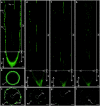Expression and distribution of extensins and AGPs in susceptible and resistant banana cultivars in response to wounding and Fusarium oxysporum
- PMID: 28218299
- PMCID: PMC5316987
- DOI: 10.1038/srep42400
Expression and distribution of extensins and AGPs in susceptible and resistant banana cultivars in response to wounding and Fusarium oxysporum
Abstract
Banana Fusarium wilt caused by Fusarium oxysporum f. sp. cubense (Foc) is soil-borne disease of banana (Musa spp.) causing significant economic losses. Extensins and arabinogalactan proteins (AGPs) are cell wall components important for pathogen defence. Their significance for Foc resistance in banana was not reported so far. In this study, two banana cultivars differing in Foc sensitivity were used to monitor the changes in transcript levels, abundance and distribution of extensins and AGPs after wounding and Foc inoculation. Extensins mainly appeared in the root cap and meristematic cells. AGPs recognized by JIM13, JIM8, PN16.4B4 and CCRC-M134 antibodies located in root hairs, xylem and root cap. Individual AGPs and extensins showed specific radial distribution in banana roots. At the transcript level, seven extensins and 23 AGPs were differentially expressed between two banana cultivars before and after treatments. Two extensins and five AGPs responded to the treatments at the protein level. Most extensins and AGPs were up-regulated by wounding and pathogen inoculation of intact plants but down-regulated by pathogen attack of wounded plants. Main components responsible for the resistance of banana were MaELP-2 and MaPELP-2. Our data revealed that AGPs and extensins represent dynamic cell wall components involved in wounding and Foc resistance.
Conflict of interest statement
The authors declare no competing financial interests.
Figures






References
-
- Jose-Estanyol M. & Puigdomenech P. Plant cell wall glycoproteins and their genes. Plant Physiol. Biochem. 38, 97–108 (2000).
-
- Nguema-Ona E., Vicré-Gibouin M., Cannesan M. A. & Driouich A. Arabinogalactan proteins in root-microbe interactions. Trends Plant Sci. 18, 440–449 (2013). - PubMed
-
- Raggi V. Hydroxyproline-rich glycoprotein accumulation in tobacco leaves protected against Erysiphe cichoracearum by potato virus Y infection. Plant Pathol. 49, 179–186 (2000).
-
- Shailasree S., Kini K. R., Deepak S., Kumudini B. S. & Shetty H. S. Accumulation of hydroxyproline-rich glycoproteins in pearl millet seedling in response to Sclerospora graminicola infection. Plant Sci. 167, 1227–1234 (2004).
Publication types
MeSH terms
Substances
LinkOut - more resources
Full Text Sources
Other Literature Sources
Miscellaneous

